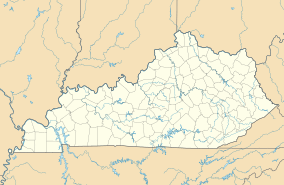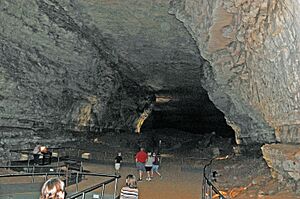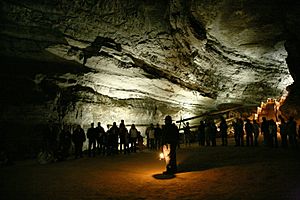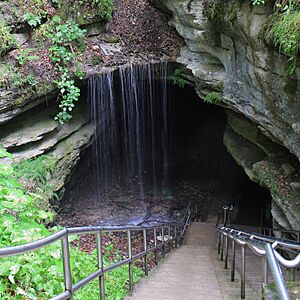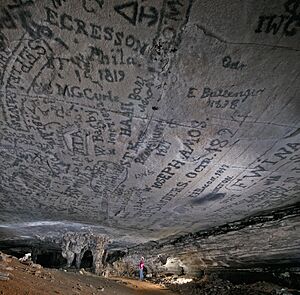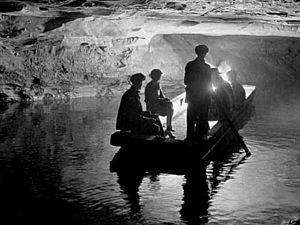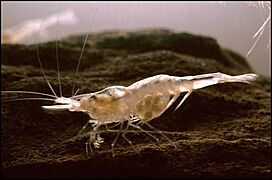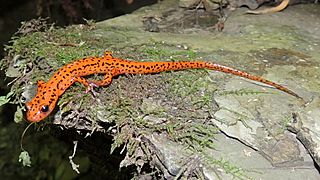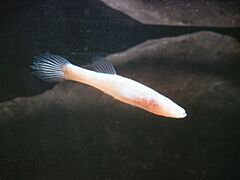Mammoth Cave National Park facts for kids
Quick facts for kids Mammoth Cave National Park |
|
|---|---|
|
IUCN Category II (National Park)
|
|

The Rotunda Room at Mammoth Cave
|
|
| Location | Edmonson, Hart, and Barren counties, Kentucky, U.S. |
| Nearest city | Brownsville |
| Area | 52,830 acres (213.8 km2) |
| Established | July 1, 1941 |
| Visitors | 533,206 (in 2018) |
| Governing body | National Park Service |
| Website | Mammoth Cave National Park |
| UNESCO World Heritage Site | |
| Criteria | Natural: vii, viii, x |
| Inscription | 1981 (5th Session) |
Mammoth Cave National Park is a special national park in south-central Kentucky, USA. It protects a huge part of the longest known cave system in the world, called Mammoth Cave. The park covers about 52,830 acres (21,380 hectares). Most of it is in Edmonson County. Smaller parts stretch into Hart and Barren counties. The Green River flows through the park. A smaller river, the Nolin River, joins the Green River inside the park.
Since 1972, the cave system has been officially known as the Mammoth–Flint Ridge Cave System. This is because explorers found a connection between Mammoth Cave and an even longer cave system under Flint Ridge. As of 2022, more than 426 miles (686 km) of passages have been mapped. This makes it over 1.5 times longer than the second-longest cave system, Mexico's Sac Actun underwater cave.
The park became a national park on July 1, 1941. It was named a World Heritage Site in 1981. It also became an international Biosphere Reserve in 1990. In 2021, it was recognized as an International Dark Sky Park.
Contents
- Why is Mammoth Cave National Park Important?
- How Mammoth Cave Formed: The Geology Story
- Visiting Mammoth Cave National Park
- Mammoth Cave's Long History
- Ancient People and the Cave
- Early European Discoveries and Saltpeter Mining
- The 19th Century: Tourism and Stephen Bishop
- The Kentucky Cave Wars (Early 20th Century)
- The National Park Movement (1926–1941)
- Becoming the Longest Cave (1954–1972)
- The Big Connection: Flint–Mammoth (1972)
- Recent Discoveries and Connections
- Climate and Weather at Mammoth Cave
- Animals and Plants of Mammoth Cave
- What Does "Mammoth" Mean in the Cave's Name?
- Images for kids
- See also
Why is Mammoth Cave National Park Important?
Mammoth Cave National Park was created for several important reasons. It aims to protect and study the amazing natural features of the world's longest known cave system. This includes its unique plants and animals, and how the cave formed.
The park also protects the beautiful karst landscape above ground. This type of land has lots of sinkholes and caves. The Green and Nolin rivers are also part of the park. Plus, the park preserves a lot of human history found in the area. It also helps people enjoy and learn about this special place.
How Mammoth Cave Formed: The Geology Story
Mammoth Cave formed in thick layers of limestone. These layers are covered by a strong layer of sandstone. This sandstone acts like a cap, making the cave system very stable. Over 400 miles (640 km) of passages are known. New discoveries add more miles every year.
The Role of Sandstone and Limestone
The top sandstone layer is called the Big Clifty Sandstone. It's hard for water to get through, except where there are cracks. This means many older, higher parts of the cave are very dry. You won't see many stalactites or stalagmites there. These formations need dripping water to grow.
Below the sandstone are layers of limestone. These include the Girkin Formation, Ste. Genevieve Limestone, and St. Louis Limestone. Water slowly dissolves the limestone, creating the cave passages. For example, the large Main Cave passage you see on the Historic Tour is in the Girkin and Ste. Genevieve Formations.
Sometimes, the sandstone caprock has worn away. This allows water to reach the limestone below. An example is the Frozen Niagara room, where you can see many cave formations.
Unique Landforms: Sinkholes
In the southern part of the park, there's a huge sinkhole called Cedar Sink. A small river flows into one side of this sinkhole. Then, it disappears underground on the other side. This shows how water moves through the karst landscape.
Visiting Mammoth Cave National Park
The National Park Service offers many different cave tours. You can see famous spots like Grand Avenue and Frozen Niagara. Some tours are lit by electric lights, lasting from one to six hours. Other tours use old-fashioned paraffin lamps, which is a unique experience. There are also "wild" tours for adventurous visitors. These tours go into muddy crawls and dusty tunnels.
The park's main visitor center is on Mammoth Cave Parkway. You can get to the park directly from I-65 at Exit 48.
Mammoth Cave's Long History
Humans have been connected to Mammoth Cave for over five thousand years.
Ancient People and the Cave
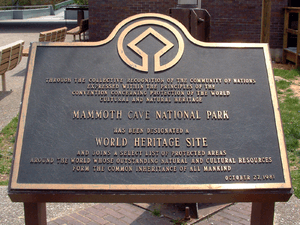
Many remains of Native American people have been found in Mammoth Cave. Most of these were intentional burials. They show how ancient people buried their dead.
One interesting discovery was "Lost John" in 1935. He was an ancient miner who died when a large rock fell on him. His remains were displayed for many years. Later, they were respectfully reburied in a secret spot in the cave.
Scientists like Patty Jo Watson have studied the lives of these ancient people. They learned that early groups were hunter-gatherers. Over time, they started to grow plants and farm. Researchers even used "experimental archaeology". They explored the cave using the same tools as ancient people. This helped them understand the challenges faced by early explorers.
It's very important not to disturb any ancient remains or tools found in the cave. Moving them, even a little, can ruin them for research. Park explorers are trained to protect these historical treasures.
Early European Discoveries and Saltpeter Mining
The first European to visit Mammoth Cave was likely John Houchin or his brother Francis in 1797. The story says John chased a wounded bear into the cave's large entrance.
The land with the historic entrance was first recorded in 1798 by Valentine Simons. Simons started mining the cave for saltpeter. Saltpeter was a key ingredient for gunpowder. During the War of 1812, America needed a lot of gunpowder. This made mining saltpeter from Mammoth Cave very important and profitable.
In 1812, Charles Wilkins and Hyman Gratz bought the cave. They mined saltpeter on a large scale. They used about 70 enslaved people to do the hard work. After the war, saltpeter prices dropped. The mining stopped, and the cave became a small tourist attraction.
The 19th Century: Tourism and Stephen Bishop
In 1838, Franklin Gorin bought the cave. He wanted to make it a popular tourist spot. Gorin owned enslaved people, and he used them as tour guides. Stephen Bishop was one of these enslaved guides. He became very famous for his knowledge of the cave.
Stephen Bishop was one of the first people to create detailed maps of the cave. He also named many of its features. Gorin wrote that Stephen was the first to cross the "Bottomless Pit." He helped discover many new parts of the cave.
In 1839, John Croghan bought the Mammoth Cave Estate, including Stephen Bishop and other enslaved people. Croghan tried to use the cave as a tuberculosis hospital for a short time. He believed the cave air would cure his patients, but it didn't work. Croghan himself died from tuberculosis in 1849.
Mammoth Cave became very famous around the world in the 19th century. Many famous people visited, like singer Jenny Lind and violinist Ole Bull. They even performed a concert in one of the cave chambers. Today, two rooms are named "Booth's Amphitheatre" and "Ole Bull's Concert Hall."
The Kentucky Cave Wars (Early 20th Century)
Life was hard for farmers in the cave region. So, owners of smaller caves nearby tried to make money from tourism. This led to the "Kentucky Cave Wars." It was a time of fierce competition to attract visitors.
Some cave owners used tricky methods. They put up misleading signs to guide tourists away from Mammoth Cave. They even had people called "cappers" who would jump onto tourists' cars. These cappers would tell visitors that Mammoth Cave was closed or unsafe.
In 1908, a German engineer named Max Kämper visited the cave. He stayed for months and, with guide Ed Bishop, made very accurate maps of many miles of Mammoth Cave. He also found new passages.
Later, in the 1920s, George Morrison used blasting to create new entrances to Mammoth Cave. These entrances were on land not owned by the Croghan family. This showed that the Croghans had been showing parts of the cave that weren't on their property. Lawsuits followed, and different entrances competed directly.
The National Park Movement (1926–1941)
After the last Croghan family members died, people in Kentucky wanted to create a national park. A group of citizens formed the Mammoth Cave National Park Association in 1924. The park was officially approved on May 25, 1926.
Money was donated to buy some of the land. Other land was taken by the government for public use. Unlike parks in less populated areas, thousands of people had to move to create Mammoth Cave National Park. This process was often difficult for landowners.
The Civilian Conservation Corps (CCC) helped develop the park from 1933 to 1942. They built roads and trails. By May 22, 1936, over 27,000 acres had been bought. Mammoth Cave was officially declared a national park on July 1, 1941.
Becoming the Longest Cave (1954–1972)
By 1954, almost all the land within the park's boundaries belonged to the National Park Service. However, two private areas remained. One was the old Lee Collins farm, which had a show cave called Collins Crystal Cave. This cave competed with the national park.
In 1954, an expedition called C-3 explored Crystal Cave. They found that its passages extended towards Mammoth Cave. This information was kept secret at first. Explorers feared the National Park Service might stop their work if they knew.
In 1955, Crystal Cave was connected to Unknown Cave. This was the first connection in the Flint Ridge system. Some explorers from the C-3 expedition formed the Cave Research Foundation (CRF) in 1957. They wanted to support scientific research in the caves.
In 1961, the Crystal Cave and Great Onyx Cave properties were sold to the National Park Service. The CRF was allowed to continue its explorations. By 1972, the Flint Ridge Cave System was mapped to 86.5 miles (139.2 km). This made it the longest cave in the world.
The Big Connection: Flint–Mammoth (1972)
During the 1960s, CRF teams found passages in the Flint Ridge Cave System that were very close to Mammoth Cave. In 1972, CRF cartographer John Wilcox pushed hard to connect the caves.
On August 30, 1972, a team including Patricia Crowther found a narrow passage called the "Tight Spot." Beyond it, they found a river passage with the name "Pete H" carved on the wall. This was believed to be from Warner P. "Pete" Hanson, an explorer from the 1930s. The passage was named Hanson's Lost River.
Finally, on September 9, 1972, a six-person CRF team followed Hanson's Lost River. They discovered it connected to Echo River in Cascade Hall of Mammoth Cave. This was a huge achievement! The combined cave system now had 144.4 miles (232.4 km) of mapped passages and fourteen entrances. It was truly the "Everest of speleology."
Recent Discoveries and Connections
Since 1972, more connections have been made. In 1979, Mammoth Cave connected to Proctor/Morrison Cave. This pushed exploration further southeast.
In 1983, Roppel Cave, a large cave outside the park, was connected to the Mammoth Cave System. This connection was made by explorers from both the CRF and another group called the Central Kentucky Karst Coalition (CKKC). This brought the total mapped length to nearly 300 miles (480 km).
On March 19, 2005, another connection was made from a small cave under Eudora Ridge. This added about three more miles to the system. The new entrance, called the "Hoover Entrance," was found in 2003. Since then, more discoveries have pushed the total length to over 400 miles (640 km).
Scientists believe many more miles of passages are still waiting to be found. New natural entrances are rare. Most new discoveries happen when explorers follow side passages from known entrances.
Other Nearby Cave Systems
There are other huge cave systems near Mammoth Cave. The Fisher Ridge Cave System was found in 1981. It has been mapped to 131 miles (211 km). The Martin Ridge Cave System was discovered in 1976. As of 2018, it was mapped to 34 miles (55 km), and exploration continues.
Seven miles from the visitor center is Diamond Caverns. You can see an old stagecoach there. It used to take visitors from the train stop to both Diamond Caverns and Mammoth Cave.
Climate and Weather at Mammoth Cave
Mammoth Cave National Park has a Humid subtropical climate. This means it has hot, humid summers and mild winters. The average lowest temperature in winter is about -3.2°F (-19.6°C).
| Climate data for Mammoth Cave National Park, Kentucky (1991–2020 normals, extremes 1934–present) | |||||||||||||
|---|---|---|---|---|---|---|---|---|---|---|---|---|---|
| Month | Jan | Feb | Mar | Apr | May | Jun | Jul | Aug | Sep | Oct | Nov | Dec | Year |
| Record high °F (°C) | 80 (27) |
82 (28) |
86 (30) |
91 (33) |
96 (36) |
108 (42) |
108 (42) |
105 (41) |
106 (41) |
99 (37) |
93 (34) |
80 (27) |
108 (42) |
| Mean maximum °F (°C) | 65.6 (18.7) |
71.4 (21.9) |
78.4 (25.8) |
85.1 (29.5) |
90.7 (32.6) |
95.2 (35.1) |
96.9 (36.1) |
96.1 (35.6) |
94.0 (34.4) |
86.6 (30.3) |
76.7 (24.8) |
67.5 (19.7) |
98.2 (36.8) |
| Mean daily maximum °F (°C) | 47.9 (8.8) |
53.2 (11.8) |
62.3 (16.8) |
73.4 (23.0) |
81.2 (27.3) |
88.0 (31.1) |
91.0 (32.8) |
90.2 (32.3) |
85.0 (29.4) |
74.0 (23.3) |
61.2 (16.2) |
51.0 (10.6) |
71.5 (21.9) |
| Daily mean °F (°C) | 38.6 (3.7) |
42.7 (5.9) |
50.9 (10.5) |
60.7 (15.9) |
69.0 (20.6) |
76.2 (24.6) |
79.6 (26.4) |
78.5 (25.8) |
72.5 (22.5) |
61.6 (16.4) |
50.5 (10.3) |
42.0 (5.6) |
60.2 (15.7) |
| Mean daily minimum °F (°C) | 29.3 (−1.5) |
32.2 (0.1) |
39.5 (4.2) |
48.0 (8.9) |
56.8 (13.8) |
64.4 (18.0) |
68.3 (20.2) |
66.7 (19.3) |
60.0 (15.6) |
49.1 (9.5) |
39.7 (4.3) |
33.0 (0.6) |
48.9 (9.4) |
| Mean minimum °F (°C) | 4.5 (−15.3) |
10.4 (−12.0) |
18.0 (−7.8) |
29.0 (−1.7) |
38.6 (3.7) |
49.2 (9.6) |
57.0 (13.9) |
54.1 (12.3) |
42.9 (6.1) |
30.1 (−1.1) |
20.0 (−6.7) |
12.1 (−11.1) |
2.7 (−16.3) |
| Record low °F (°C) | −20 (−29) |
−21 (−29) |
−6 (−21) |
18 (−8) |
27 (−3) |
32 (0) |
40 (4) |
37 (3) |
29 (−2) |
18 (−8) |
−8 (−22) |
−18 (−28) |
−21 (−29) |
| Average precipitation inches (mm) | 3.73 (95) |
4.47 (114) |
5.01 (127) |
4.92 (125) |
5.16 (131) |
4.84 (123) |
4.93 (125) |
3.82 (97) |
3.95 (100) |
3.79 (96) |
4.09 (104) |
4.78 (121) |
53.49 (1,359) |
| Average snowfall inches (cm) | 0.7 (1.8) |
1.4 (3.6) |
0.6 (1.5) |
0.0 (0.0) |
0.0 (0.0) |
0.0 (0.0) |
0.0 (0.0) |
0.0 (0.0) |
0.0 (0.0) |
0.0 (0.0) |
0.0 (0.0) |
1.3 (3.3) |
4.0 (10) |
| Average precipitation days (≥ 0.01 in) | 11.5 | 10.8 | 12.9 | 11.9 | 12.1 | 11.9 | 10.7 | 9.1 | 7.9 | 9.0 | 9.5 | 11.5 | 128.8 |
| Average snowy days (≥ 0.1 in) | 0.4 | 0.7 | 0.6 | 0.1 | 0.0 | 0.0 | 0.0 | 0.0 | 0.0 | 0.0 | 0.0 | 0.4 | 2.1 |
| Source: NOAA | |||||||||||||
Animals and Plants of Mammoth Cave
Mammoth Cave is home to many interesting creatures, especially bats.
Bats in the Caverns
Several types of bats live in the caverns. These include the Indiana bat (Myotis sodalis) and the gray bat (Myotis grisescens). Other species are the little brown bat (Myotis lucifugus), big brown bat (Eptesicus fuscus), and the tricolored bat (Perimyotis subflavus).
In the past, millions of bats lived in the Historic Section of the cave. Now, their numbers are much smaller, only a few thousand. The park is working to help the bat populations grow again. Some bats, like the red bat, live in the forest and are rarely found underground.
Other Cave Animals
Many other animals live in the caves. You can find two kinds of crickets (Hadenoecus subterraneus and Ceuthophilus stygius). There's also a cave salamander (Eurycea lucifuga). Two types of eyeless cave fish (Typhlichthys subterraneus and Amblyopsis spelaea) also call the cave home. You might also see a cave crayfish (Orconectes pellucidus) and a cave shrimp (Palaemonias ganteri).
Some surface animals might hide near the cave entrances. But they usually don't go deep into the dark parts of the cave system.
Rivers and Forests
The Green River flows through the park. This part of the river is special. It's called a "Kentucky Wild River." This means it's protected for its natural beauty.
The forests in the park are mostly Oak and Hickory trees. These are common in Eastern Hardwood forests.
Ancient Life: Fossils in the Cave
The limestone in the cave holds many fossils. You can find fossils of ancient sea creatures like crinoids and blastoids. There are also gastropods, which are like ancient snails. Scientists have even found fossils of more than a dozen types of sharks! In 2020, they found part of a Saivodus striatus, a shark as big as a modern great white shark.
What Does "Mammoth" Mean in the Cave's Name?
The name "Mammoth Cave" refers to how wide and long the passages are. The cave's main entrance leads to a huge room called the Rotunda. The name was used long before explorers knew just how incredibly long the cave system was. It has nothing to do with woolly mammoths, the extinct furry elephants. No fossils of woolly mammoths have ever been found in Mammoth Cave.
Images for kids
See also
 In Spanish: Parque nacional de Mammoth Cave para niños
In Spanish: Parque nacional de Mammoth Cave para niños
- Carlsbad Caverns National Park
- Colossal Cavern
- Karst topography
- List of longest caves
- List of caves
- List of Biosphere Reserves in the United States
- List of caves in the United States
- List of longest caves in the United States
- List of national parks of the United States
- Index of conservation articles
- Speleology


